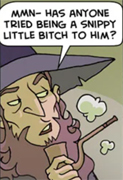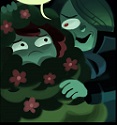|
Another useful set of templates available are the Lulu pdf templates. They'll flatten things and subset fonts appropriately for good quality ebooks and print masters. (My day job causes me to live in InDesign. potatocubed is not lying about the learning curve, but once you 'get it', you can do amazing things.)
|
|
|
|

|
| # ? Jun 2, 2024 06:46 |
|
potatocubed posted:Alright, let's see if I can hand over some of my layout knowhow, such as it is. Thank you so much for this! And since I am stuck with Scribus, I'd be really keen to see your effortpost on it when you feel like doing one. Here's another dumb question, (at least my gut tells me it's dumb, but I don't actually know why) If I can set up margins and boxes and stuff via Inkscape, and it's a bit friendlier in terms of what can go where. Why couldn't I just make every page in Inkscape and then bring them together 'somehow' later on? I could make a Master page, and then copy that over and add my text when/where ever.
|
|
|
|
Error 404 posted:Thank you so much for this! And since I am stuck with Scribus, I'd be really keen to see your effortpost on it when you feel like doing one. The main problem you'd have doing everything in Inkscape would be text. Although Scribus' text editing is horrible, Inkscape's is worse. Also, you'd be exporting all your pages as images. One of the big advantages of using a DTP program is that the pdf you get out the end has text recognition built right in, so people can search it for keywords, copy/paste and so on. If you went the Inkscape route that wouldn't work because all your text would be pictures of text instead. You could very well do a sort of background layout in Inkscape and pull that in, then flow text around it, but if you suddenly realised you needed to re-lay something you'd be out of luck. I've seen something similar done with Photoshop, and uttered creative profanity when I inherited that project and had to adjust the layout later. For all that I rag on DTP software, it really is the best way of doing what it does. I recommend biting the bullet and getting stuck in. Actually, here's something else worth knowing: you can get plenty far in Indesign or Scribus with nothing but frames and patience. I'm sitting on top of literal years of experience, so I'm here bombarding you with stuff I wish I'd known when I started - but the first stuff I laid out was done with nothing more complex than text frames, image frames, a few blocks of black or white, and paying careful attention to the guide rules. In fact, the very first bit of layout work I did was on a flyer for a major retail chain, and I used long thin boxes all over the place because I couldn't work out how to do underlined text. 
|
|
|
|
I use Google Docs to write my books. Google Docs supports styles but unfortunately Google Docs does not export directly to InDesign, so what I do is export to an intermediary format (RTF) and then drop the text into my InDesign document. It's clunky, and it only preserves some of the formatting, but it gets the job done.
|
|
|
|
Working more on lost in the woods, and I have a first draft of the rules, but I'm now considering a storyteller type role, and assigning some sort of "energy" system. I was kind of set on having no opposing force and everyone works together, but it would make some of the mechanics of running that side run smoother. One thing I was considering is a "back and forth" energy system like quick-strike, but I don't remember particularly really liking that game or how that mechanic worked, and I wonder if it's innately a part of the mechanic. Basically, the idea is the energy you spend on a failed attack goes to the opponent on their attack. It always feels like a false choice, basically punishing you for doing better moves. Then again, I guess it's more a thing about risk, and how much you think that attack will hit. I don't remember any other games that really use that mechanic (LotR: the CCG I think maybe but I could never understand how to play that game), can anyone think of a game that uses that mechanic well? Edit: And another thought that occurs to me is having a storyteller would make this more predictable, I like the idea of ups and downs being unexpected. Whereas if there's some sort of energy system, it's going to be clear if the storyteller plays a positive event (one that players get to trade for example) it's because their storing up for a worse event. Then again, maybe that just means I need to make all the events not clearly good, and I should do so anyway. (For example. the trader tries to rip them off). Edit 2: And I like the idea of "companions" you pick up on the way possibly secretly hindering you instead of helping, (like for the checks to overcome obstacles which is using items to get a bonus on a die roll to a target number) but I'm not sure how that'd work. I like the idea of the companion leading off-course, but traveling is represented by a deck, and it'd be hard to manipulate it without the players knowing. Foolster41 fucked around with this message at 01:43 on Nov 25, 2014 |
|
|
|
Thanks, in part, to things I have read in this thread, I have finished my first product, Wizard Battle! Please add it to the OP.
|
|
|
|
I didn't post it, because I was working on a big rewrite, but here's my latest draft of Lost in the woods. Feedback is welcome. I'm not very good at writing clear rules, and this was written at about 3 in the morning.
|
|
|
|
I'm tentatively sharing this blog post I wrote about this RPG project that I've been loving around for like, 5 years at this point. It might not be very easy to understand, but hey, maybe someone will find this interesting and give me a kick in the rear end to finish it. This iteration is based on Apocalypse World, but the game is honestly system agnostic, judging by how many times I've changed it and ran it with among others, Fate, Storyteller and Nemesis. I suck at system design so bad. I plan to bring it back to the updated version of Fate, cut out some of the mechanics because it's bloated and see where that takes me. http://cotronis.com/dark-days-rpg/
|
|
|
|
Mad Rancher posted:Working a project called Wizard Battle, I ran a tentative version of it during a game I ran a while back, Cheat Game, as the ultimate game winning title. The game will be a very complicated one due to the time travel mechanics; rule explanations relating to manipulate time span a total of two pages in this relatively short 30 page game doc (no images except title page). I feel the overtly complicated nature of the game will put off many players who would otherwise buy it. What sort of options are available to me to reduce this effect, beyond 'lie in marketing and watch as the wrong demographic gives me bad reviews'? Oh hey look what just made it into the OP!
|
|
|
|
PSA for game writers out there: There is a free font called Dyslexie that was designed by people with dyslexia to help them read with as little difficulty as possible. You can get it here: http://www.dyslexiefont.com/en/ I recommend using it for the main font of anything you put out there, just to be user friendly. If you don't like the look of it, at least changing fonts is super easy, so you can always make "standard" and "dyslexia-friendly" versions of any PDFs you put out with minimal difficulty.
|
|
|
|
gnome7 posted:PSA for game writers out there: There is a free font called Dyslexie that was designed by people with dyslexia to help them read with as little difficulty as possible. You can get it here: http://www.dyslexiefont.com/en/ As someone who is dyslexic, I recommend making your fonts changeable if you are publishing online. Just reading the dyslexia friendly fonts (I'm more familiar with Open Dyslexic), I understand why many other dyslexics find they help. It feels as if someone has taken each individual letter and nailed it to the page so it won't float away. I can't read more than a few paragraphs of Open Dyslexic without getting a headache as the normal methods I use to read freely and at speed have suddenly become counter-productive. And you might want to check the license for dyslexie. It's not a free license - just free to use on your own computer; they charge for commercial use. neonchameleon fucked around with this message at 04:23 on Nov 27, 2014 |
|
|
|
neonchameleon posted:And you might want to check the license for dyslexie. It's not a free license - just free to use on your own computer; they charge for commercial use. I missed that part, thanks for the heads up. I'll need to look into that then.
|
|
|
|
I don't consider it an entirely separate project considering that I could reuse a lot of system-less stuff, but yesterday I published my OSR version of playable monster PCs. B/X games like Labyrinth Lord are the most popular in terms of fanbase and 3rd party support in the OSR, so I went with the "race as class" thing like they do for elves and dwarves but for monsters. Giants are really tall brawlers with some rock-throwing ranged attacks, dryads are nature priestesses, doppelgangers are versatile sneaky dudes, stuff like that. And since goblins aren't a PC option in OSR games like they are in Pathfinder, I made a new entry for them! Reusing existing material for other systems is good for several reasons: on the one hand, you won't have to pay for new stock art and the customer bases are separate enough that you can spread your good ideas to more people. On the other hand, straight conversions between different rule-sets never work out in practice, so instead you have to make things anew in the rule-set if you want your thing to be good. A Strength 18 in Pathfinder ain't the same thing as a Strength 18 in Labyrinth Lord! Right now I've been releasing small sourcebooks on a monthly basis, but now that I have this out of the way I plan on focusing entirely on my bigger project, Arcana High. Pray for me.
|
|
|
|
Any advice on converting people who are interested in my product - added it to their wishlist or cart - into customers? I have quite a few of those, and even half bought it'd help a lot with my rankings (thus bringing in more potential customers). Is there really anything I can do besides give a special discount code?
|
|
|
|
Well, coming from a board game background, reading your product page, I'm not sure what Wizard Battle even is. It could be that some people are interested in the theme, but don't want to spend almost 10 dollars on a game that they have no idea what mechanics it has or how it plays. Maybe like, a sample spell and a rules overview? I know that might sell me on it, at least.
|
|
|
|
I started writing a game I call "Basically that knockoff dice game from yugioh, but for Magic: the Gathering." The players each have some mana dice and cards for spells. Each turn, everyone rods their dice and then goes around the table spending them to cast spells. To cast a spell, a player uses up some of their dice with the right color and number. For example, casting Counterspell might cost a blue die showing the number 2. Each player starts with their dice in their Collection. They each add one die from the Collection into their available mana each turn. When they spend these dice, they move into the spent pool. The spells players cast can be Sorceries, Instants and Summons. Sorceries are big, slow effects, Instants are the quick reaction spells and Summons create permanent monsters to beat up your enemies. At the end of the turn, monsters fought and everyone gets their spent dice back. One thing I want to avoid is the situation where the dice leave a player just completely unable to do anything useful. I've two ideas right now to avoid this: First off, right now each player always has a spell for each number they might roll. I might abandon this one at some point if I add spell customization so that figuring out a good combination of spells that you're not boned without perfect rolls becomes a test of skill, like deck building. Second is dice combining. When casting a spell players can add multiple dice together to get a new number ("wrapping" around if the total exceeds 6) so that it's very likely that a player can do what they need at any given time, with luck determining the amount of resources it takes to do it. This also make the probabilities likely almost impossible to calculate.
|
|
|
|
Right now I'm working on a game called RPG: Reality Playing Game (previously Rule Playing Game), a competitive role playing game about the players versus GM (in this game, RM (Reality Master)) to change the laws of the universe (the way the game plays). Opinions on the concept? Do any RPGs exist with a similar theme?
|
|
|
|
Mad Rancher posted:Opinions on the concept? Do any RPGs exist with a similar theme? Not RPGs, but Fluxx has a similar rule-bending approach, and the granddaddy of rule-making games is Nomic.
|
|
|
|
potatocubed posted:Not RPGs, but Fluxx has a similar rule-bending approach, and the granddaddy of rule-making games is Nomic. Great; I know of both of those, I just wanted to make sure the rule manipulating space had yet to be explored in tabletop RPGs.
|
|
|
|
potatocubed posted:Not RPGs, but Fluxx has a similar rule-bending approach, and the granddaddy of rule-making games is Nomic. The card game Mao is pretty good at it too.
|
|
|
|
I'm looking for someone to bounce ideas off of, are any of you guys are interested in a FATE/AW game about an organization like Hellboy's B.P.R.D only everyone is possessed by a demon? I'll be posting more concrete stuff when I've written them down, but it'd be really useful for me to chat with someone about the themes of the game and how to stay true to the original material.
|
|
|
|
ravenkult posted:I'm looking for someone to bounce ideas off of, are any of you guys are interested in a FATE/AW game about an organization like Hellboy's B.P.R.D only everyone is possessed by a demon? You mean Orpheus with the serial numbers filed off? I'm kidding, that sounds pretty cool. I fuckin love BPRD.
|
|
|
|
Error 404 posted:You mean Orpheus with the serial numbers filed off? I wouldn't say Orpheus, I'm trying to do B.P.R.D as close as possible but maybe without dudes like Hellboy or Liz. So lower powered and maybe leaning more towards horrific stuff, without the angst.
|
|
|
|
Having given it the old 'Thou Shalt Not Use Cursive Fonts' a few posts back, I find myself in need of a font which looks like someone's handwritten it, but remains entirely legible. Anyone got any recommendations?
|
|
|
|
potatocubed posted:Having given it the old 'Thou Shalt Not Use Cursive Fonts' a few posts back, I find myself in need of a font which looks like someone's handwritten it, but remains entirely legible. Anyone got any recommendations? Papyrus?
|
|
|
|
Comic Sans!
|
|
|
|
|
potatocubed posted:Having given it the old 'Thou Shalt Not Use Cursive Fonts' a few posts back, I find myself in need of a font which looks like someone's handwritten it, but remains entirely legible. Anyone got any recommendations? Check out Blambot Fonts made for comic book lettering are all highly readable and look like they're handwritten (but not cursive). He's also got a few fonts that are cursive-ish like Ladylike. Many of his fonts are free for anyone except Marvel and DC and the rest are reasonably priced.
|
|
|
|
You could always just hand-letter it yourself, or hire someone to do that.
|
|
|
|
I know that I said several months earlier that I was going to focus on Arcana High being a retro-clone, but over the months I realized that I had to focus on one thing for it if I'm going to be doing other work projects. Making a retroclone, Pathfinder supplement, and adventure is effectively 3 projects at once. Combined with an unrelated book I'm writing as well, I decided to focus on designing an adventure. The reason I'm doing this is that I already have a wealth of material for a Pathfinder adventure, so I'm taking the path of least resistance. I do plan on expanding the magic high school idea into multi-system sourcebooks, but right now those are not my current projects. So my Arcana High project is not only going to be Pathfinder, it's going to be the first in a series of linked adventures. An Adventure Path, although it won't go up to 20th level (planning on sticking to a 1st through 12th level arc). The general plot is that the PCs are new students at a famed magic academy in a metropolitan city, but after an evil power begins to reveal itself, they end up bearing the legacy of famed heroes of old in the form of magical relics. In between the everyday drama of study and high school social cliques, the PCs would take on masked identities with the relics. On top of all this is a giant series of ruins beneath the school housing demons and other evil entities as prisoners who are just beginning to break out. I'm thinking a mix of Harry Potter, Persona 3, Sailor Moon, and Batman/Spider-Man. If it makes any difference, a lot of the ideas I have in mind were developed as the result of several months of such a campaign with my regular gaming group. Does this change things or detail any complications I should consider? Any advice for writing an Adventure Path? Do's and don'ts? Regarding playtesting reports, should I rerun the adventure as normal or stick to the combat encounters (the bread and butter of Pathfinder) as the primary thing to be playtested? Miscellaneous Ideas: Some of these are new, others are ones I've developed as a result of direct play. Everyone's a Spellcaster: Specifically, a spellcasting class which gets spells at 1st level. Fortunately Pathfinder's versatile enough even in 1st Party material that all roles can be filled. The Magus makes a great fighter, and the Alchemist and Archeologist Bard are good skill-monkeys. The magic school teaches and studies divine magic as well as arcane, so Cleric, Druid, and Oracle students are present alongside Magic, Summoners, and Wizards. At low levels non-casting classes are viable, but even then they don't always have as versatile assortment of toys. It's not very superheroic if all you can do is punch people and are bad at noncombat skills. Relics: Each PC gets a magical relic which allows them to assume a superhero identity. Every level they gain an upgrade, a special ability which they can use either while wielding the relic on their person or in transformed mode. I deliberately made it so that the upgrades mimic the effects of existing popular magic items to make the PCs less equipment-dependent, and have consulted the Wealth by Level chart for such an occurrence. Gaining treasure and unique magical items can still occur in the adventure, but the relics are intended to shore up most of the mundane magic items (enhancement bonuses to saving throws, armor class, etc). So instead of stockpiling money for a +2 Cloak of Resistance or +1 Longsword, the PC's batcave/arsenal can afford to have more unorthodox and wondrous magic items like that Crab-Tank artifact, an Immovable Rod, a legendary dragon-slaying sword, etc. Sidequest Chain: Heavily inspired in part by Persona's Social Link system, Arcana High will have a series of sidequests adjunct to main quest events. They comprise of things like the troubles and worries of friendly NPCs, plots of minor villains to stop, sneaking to the forbidden section of the library to find a rare book, et cetera. Sidequests are necessary to do in addition to the main quest, but not all of them need to be done and the GM can mix and match specific ones which he thinks will provide the most enjoyment. That way, each Arcana High campaign will be unique! Experience: I find tracking experience points a chore, so I considered doing this. The PCs gain a level at certain points in the campaign, where they must have progressed as such among the main quest chain with a minimum number of side quests. Instead of marking progress by each and every monster defeated, emphasis on leveling up will be based among completed quests. Thoughts? Advice? Concerns? Libertad! fucked around with this message at 21:20 on Dec 20, 2014 |
|
|
|
A BPRD setting RPG sounds awesome, if it was keeping with the tone (fighting horrors, but not too serious) I'd totally be interested. ... Major revamp of Feint wars. I removed the dice element completely. Instead you play cards from your hand (of 5 cards) that are numbered 1-12. The attacker wants to meet or beat the number, but not go too far over. I'm trying to go for a dark souls-esque dueling feel. One problem is, I'm not sure how confusing the wording of the rules are. Here's the portion of the rules: Melee Attack When a unit attacks another unit, both players play face down a card from their hand and then reveal them simultaneously. If the attacker's card is equal or higher than the defender's card, but doesn't beat the card by 5 or more then.... Find out the attacking unit's Minimum range. Minimum range is equal to the difference between the number of squares they are away from the target and their range (subtract the higher number from the lower one). If the attacking player's card doesn't beat the defender's card by their minimum range, the attack is a miss. For example, a unit with a knife (1 range) is attacking a spear-man (3 range) and is 2 squares away. The knife unit must beat the defender's card by at least 2 to hit. But, if a swordsman (2 range) fights another swordsman (2 range) and they are 2 spaces apart, then the attacker's minimum range is 0, and a tie will hit. Counter If the attacker's card beats the defender's card by 5 or more, then they are counter-attacked and the defending unit does damage equal to their own damage value to the attacker instead. <I'm not sure about counters always hitting> ... Is this confusing? An interesting result of this system is I'm doing away with is attack/defense numbers. Instead better units will simply have better special abilities.
|
|
|
|
Just finished an extremely rough draft for the Savage Worlds/PDQ hybrid attempting to emulate Exalted which I am currently calling Badass Kung-Fu Demigods. If anyone has the time to look it over and offer any suggestions and/or scathing critiques I'd appreciate it. https://drive.google.com/file/d/0B5dkSHCjlC_3OWphSFhlZlJfUDA/view?usp=sharing
|
|
|
|
Initial thoughts: Exploding dice may make d4s more likely to run away than is desirable. Do you really want to go with rolled initiative?
|
|
|
|
LeSquide posted:Initial thoughts: Exploding dice may make d4s more likely to run away than is desirable. Since initiative doesn't include any particular gimmicks I was just trying to keep it simple and straightforward (with the possibility of using Energy to modify it if you want to). But I'm hardly devoted to that particular system.
|
|
|
|
Holy crap. I just discovered this thread. Where have you been all my life? I'm loving design chat and I'm getting a lot out of it. I'm at a place in my writing where the writing itself is pretty much over and I'm down to editing and design. I've been working in MS Word, though, so I may have some work to do to jump to InDesign or a similar program. I've been tooling around with Word to see what it can do for me in design, and I found it's functional, just not pretty. I may run what I have through one of the programs mentioned ITT and see how that goes. I have an easy semester coming up in terms of grading essays and such, so now I know where all my free time is going to go. I've been writing a full core book for a compete revision of 7th Sea. I'm stuck on that, though: now I don't know what to do with it. I set out to write a book that our local group could use for 7th Sea, since the first edition books got more and more mechanically broken by the end of the game's run. It started as a patchwork of house rules, and then just kept ballooning into more and more of a full rule book. Now that's exactly what it is, and I realize I would like to do something with all this work I've done besides just use it in the local group. I have no idea about the publishing rights and the intellectual property rights, though. I know who is credited with the writing, and I know what company still appears to own the publishing rights (AEG), but I have not heard anything back from either party in just asking about a hypothetical second edition of the game. The original authors are not responsive at all, and frankly hard to find a private contact (i.e. email) for them, and the only contact I can find at AEG is a useless, generic customer service email address. So, I've made the mistake of writing a whole book within someone else's intellectual property, and now I'm stuck. If worse comes to worse we can just use it as it was intended, just in our local game group, but I'd like to see this thing published somehow. Does anyone have any advice or any experience publishing under an existing license?
|
|
|
|
Your dream is probably doomed to be crushed like something soft in a fetish video. They're unlikely to suddenly pick up some random guy to write a new edition of a game they probably had no plan to make in the first place, and they're probably not going to license it out to you, either, unless you can bribe them with joke levels of money. If you really want to share your work, you're going to have to make an non-infringing fan supplement for free, or file the serial numbers off completely if you want to sell it.
|
|
|
|
Plague of Hats posted:Your dream is probably doomed to be crushed like something soft in a fetish video. They're unlikely to suddenly pick up some random guy to write a new edition of a game they probably had no plan to make in the first place, and they're probably not going to license it out to you, either, unless you can bribe them with joke levels of money. That's kind of what I figured, but I'm holding out hope. This is what I get for accidentally making a whole game book when I set out to just write up a few fixes for the group. Still, writing it was a learning experience and my next book will be better for it (and my own intellectual property). Edit: It still seems strange to me, though, that AEG would sit on this license for so long. It ran its course before the Pirates of the Caribbean franchise was everywhere, and you would think they would have wanted to do something new with a swashbuckling game while everyone was all about pirates n' poo poo. Even still, there isn't a mainstream game specifically about pirates. There's swashbuckling supplements for every game that can find a way to shoehorn one into its setting, but no swashbuckling game in and of itself in the mainstream. I clearly don't know anything about the business side of things, but if I were holding a fairly well-known license like 7th Sea, I'd want it to be making me money rather than sitting there collecting dust. Railing Kill fucked around with this message at 15:11 on Jan 7, 2015 |
|
|
|
I've been 'working' (read: binge-writing 30 pages in a day and then leaving alone for a fortnight) on a game called Wrasslehearts for a while now. Wrasslehearts is a game that's pretty closely based on Monsterhearts and it's about transferring a lot of the systems and ideas from the moody, angst ridden world of monsters and teenaged interpersonal relations to professional wrestling. It's silly and it's going pretty well. I can link it if anyone would like to see. How do you stop yourself from doing a binge on a project and then getting burnt out on it?
|
|
|
|
Sion posted:I've been 'working' (read: binge-writing 30 pages in a day and then leaving alone for a fortnight) on a game called Wrasslehearts for a while now. Wrasslehearts is a game that's pretty closely based on Monsterhearts and it's about transferring a lot of the systems and ideas from the moody, angst ridden world of monsters and teenaged interpersonal relations to professional wrestling. I just don't binge write anymore. Honestly having two jobs and a baby has helped me, but I'm probably not a typical case. I just wrote 250 pages over six months in my office between the classes I teach, and when I'm at home taking care of my baby. It took longer to write, but I think that helped me pace myself and "stay hungry" to keep writing. I never felt burned out and I always felt anxious to get back to writing because I wasn't going as fast as physically possible.
|
|
|
|
Railing Kill posted:I just don't binge write anymore. Honestly having two jobs and a baby has helped me, but I'm probably not a typical case. I just wrote 250 pages over six months in my office between the classes I teach, and when I'm at home taking care of my baby. It took longer to write, but I think that helped me pace myself and "stay hungry" to keep writing. I never felt burned out and I always felt anxious to get back to writing because I wasn't going as fast as physically possible. THIS SOUNDS LIKE COWARDICE TO ME ((yeah, I guess it's probably just a case of 'don't loving do it'))
|
|
|
|

|
| # ? Jun 2, 2024 06:46 |
|
Sion posted:THIS SOUNDS LIKE COWARDICE TO ME Haha. Oh, I get the urge to binge write. That's how I wrote in college. Over the years, though (I'm 32 now), I've found that slowing down not only helps me not get burned out, but it also helps the quality of my writing. Then again, I know some folks that do their best work in fits of inspiration. To each their own.
|
|
|





























